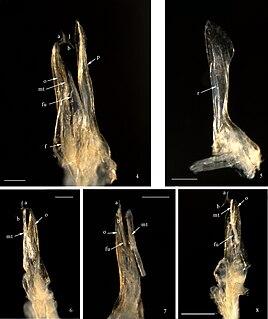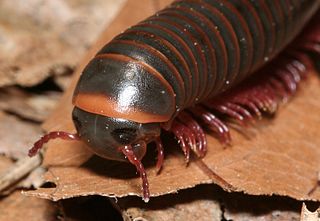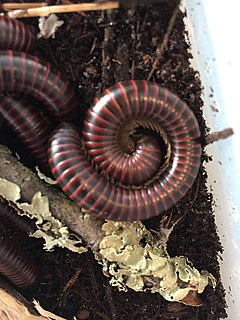Related Research Articles

Harpaphe haydeniana, commonly known as the yellow-spotted millipede, almond-scented millipede or cyanide millipede, is a species of polydesmidan ("flat-backed") millipede found in the moist forests along the Pacific coast of North America, from Southeast Alaska to California. The dark coloration with contrasting yellow-tipped keels warn of its ability to exude toxic hydrogen cyanide as a defense. Despite the various common names given the species, the coloration pattern, cyanide defense, and associated almond scent occur in other flat-backed millipedes around the world.

Spirobolidae is a family of millipedes in the order Spirobolida. The family consists of several genera with numerous species, and is commonly divided into the subfamilies Spirobolinae and Tylobolinae.

Mammamia profuga is a species of cave-dwelling millipede in the family Julidae. The only known species of the genus Mammamia, it was described in 2011 from a specimen discovered in a cave in Italy.

Motyxia is a genus of cyanide-producing millipedes that are endemic to the southern Sierra Nevada, Tehachapi, and Santa Monica mountain ranges of California. Motyxias are blind and produce the poison cyanide, like all members of the Polydesmida. All species have the ability to glow brightly: some of the few known instances of bioluminescence in millipedes.
Crurifarcimen is a monotypic genus of millipedes containing the single species Crurifarcimen vagans. Its common name is wandering leg sausage. This millipede is endemic to Tanzania, where it is known only from the Usambara Mountains. It was formally described in 2011 and placed in a newly erected genus of its own. It was declared one of the world's top 10 new species of 2012 by Arizona State University's International Institute for Species Exploration.

Narceus is a genus of large cylindrical millipedes of the family Spirobolidae native to eastern North America. The genus comprises three or four species, two of which are endemic to Florida, and the remainder forming a species complex. The species of Narceus include some of the largest and most recognizable millipedes in eastern North America.

Siphoniulus is a poorly known genus of millipede containing only two living species: S. alba from Indonesia, and S. neotropicus from Mexico and Guatemala. An additional two fossil species are known from Cretaceous amber. Siphoniulus species are the only members of the family Siphoniulidae and order Siphoniulida, making Siphoniulida the smallest millipede order. Few specimens are known, and their classification is contentious, although most recent studies place them as basal members of the Helminthomorpha.

Tylobolus is a genus of millipedes in the order Spirobolida with seven known species found in western North America. It is in the family Spirobolidae, and is the type genus of the subfamily Tylobolinae. The genus was named by Orator F. Cook in 1904.
Floridobolus is a genus of millipedes commonly known as Florida scrub millipedes containing three described species: Floridobolus penneri, F. orini, and F. floydi; the latter two described in 2014. All three species are endemic to Florida scrub habitat of peninsular Florida, and F. penneri is considered a critically imperiled species by NatureServe. Prior to the description of F. orini, the genus was considered the sole member of the family Floridobolidae, named by William T. Keeton in 1959, however studies in 2014 have argued that Floridobolus does not represent a distinct family but rather is a basal member of the family Spirobolidae, representing the subfamily Floridobolinae, and tribe Floridobolini.

Paeromopus is a genus of large cylindrical millipedes endemic to the U.S. state of California. All species exceed 10 centimeters in length, and the largest, P. paniculus, reaching 16.5 cm is the longest millipede species in North America. The genus was named by German entomologist Ferdinand Karsch in 1881 and contains four species: three occupying small ranges in the Sierra Nevada mountains and one occupying a large range including the Sierra Nevada and much of Northern California to the Central Coast.
Californiulus yosemitensis is a species of cylindrical millipede in the family Paeromopodidae that is found in western North America: predominantly in the Sierra Nevada of California but also extending into southeastern Oregon and parts of Nevada.

Paeromopus angusticeps is a species of millipede found in the U.S. state of California. It occupies the largest geographic range of all four species of Paeromopus, occupying much of Northern California in a large arc extending from Monterey County on the central coast, north along the Coast Ranges to Humboldt County, and descending along the Cascades and Sierra Nevada range of eastern California. P. angusticeps is largely absent from California's Central Valley.

Narceus gordanus is a spirobolid millipede native to the southeastern United States. Adults range from around 60 to 120 mm in length, up to 13 mm wide, and possess 45 to 65 body segments. The body color is lighter than other species of Narceus, with each body ring a light greenish tan followed by a band of darker tan. N. gordanus also has shorter legs than other Narceus species, and a deeper groove on the head in which the antennae rest.

Yantaromyrmex is an extinct genus of ants first described in 2013. Members of this genus are in the subfamily Dolichoderinae of the family Formicidae, known from Middle Eocene to Early Oligocene fossils found in Europe. The genus currently contains five described species, Y. constrictus, Y. geinitzi, Y. intermedius, Y. mayrianum and Y. samlandicus. The first specimens were collected in 1868 and studied by Austrian entomologist Gustav Mayr, who originally placed the fossils in other ant genera until the fossils were reviewed and subsequently placed into their own genus. These ants are small, measuring from 4 to 6 mm in length and can be characterized by their trapezoidal shaped head-capsules and oval compound eyes that are located slightly to the rear of the capsules midpoint, with no known ocelli present.

Eucteniza is a genus of trapdoor spiders in the family Euctenizidae containing at least 14 species occurring in Mexico and the southern United States. Species are distinguished by a softened rear portion of the carapace, and males possess large spines on the first two pairs of walking legs that are used to hold females during mating. Like other trapdoor spiders they create burrows with a hinged lid, from which they await passing insects and other arthropods to prey upon. Many species are known from only one or two localities, or from only male specimens. More species are expected to be discovered. Eucteniza is closely related to spiders of the genera Entychides and Neoapachella.

Chicobolus spinigerus, commonly known as the ivory millipede or Florida ivory millipede, is a millipede species native to the southeastern United States, occurring throughout the Florida Peninsula and panhandle, as well as southern Alabama, Georgia, and South Carolina. Males normally range from 40 to 85 mm long, females up to 90 mm (3.5 in).

Bradoponera is an extinct genus of ant in the Formicidae subfamily Proceratiinae, and is one of four genera of the subfamily. The genus contains four described species Bradoponera electrina, Bradoponera meieri, Bradoponera similis, and Bradoponera wunderlichi. The species are known from several Middle Eocene amber fossils which were found in Europe.
Hiltonius pulchrus is a species of millipede in the family Spirobolidae, endemic to the United States. It occurs in California from Kern County to San Diego County.

Tliltocatl is a genus of spiders in the tarantula family Theraphosidae. It was split off from Brachypelma in 2020. Species in Tliltocatl are found predominantly in Mexico, with some species native to Central America. They are large burrowing tarantulas, without the striking red leg markings of Brachypelma species.

Tylobolus castaneus is a species of millipede in the family Spirobolidae. It is found in Northern California, typically between Fresno and Contra Costa.
References
- ↑ Chamberlin, R. V. (1918). "New spiroboloid diplopods". Proc. Biol. Soc. Wash. 31: 165–170.
- 1 2 3 4 5 6 Keeton, William T. (1960). "A taxonomic study of the milliped family Spirobolidae (Diplopoda; Spirobolida)". Memoirs of the American Entomological Society. 17: 1–146.
- 1 2 3 4 Hoffman, R. L. (1999). "Checklist of the millipeds of North and Middle America". Virginia Museum of Natural History Special Publications. 8 (1–553).
- 1 2 Shelley, Rowland M (2010). "Occurrence of the milliped, Hiltonius carpinus carpinus Chamberlin, 1943 (Spirobolida: Spirobolidae), in the United States and new records from Mexico". Insecta Mundi. 0116: 1–3.